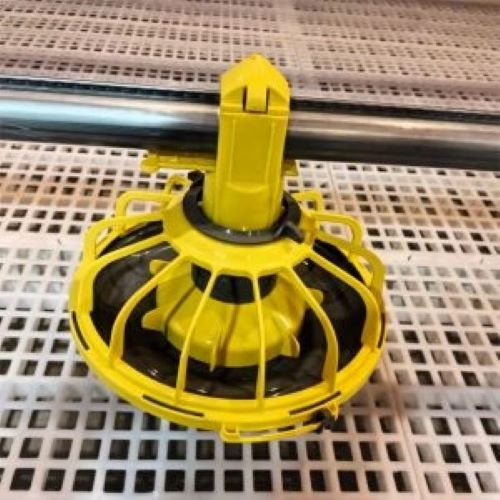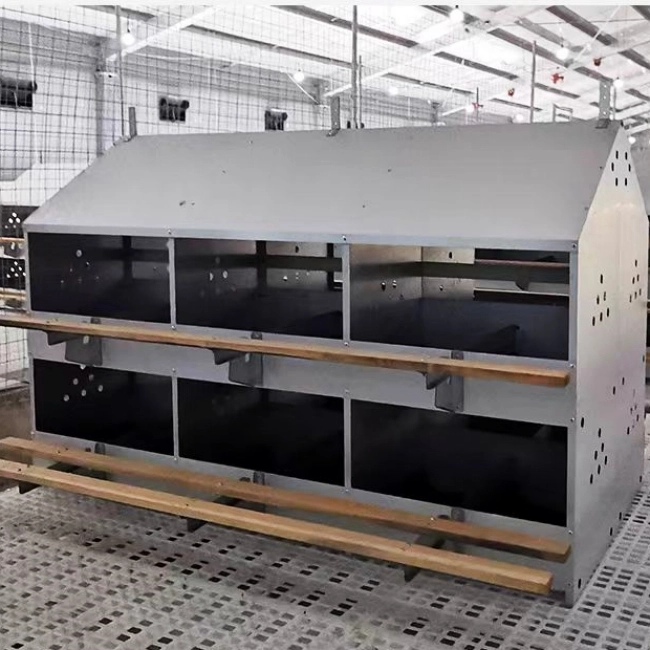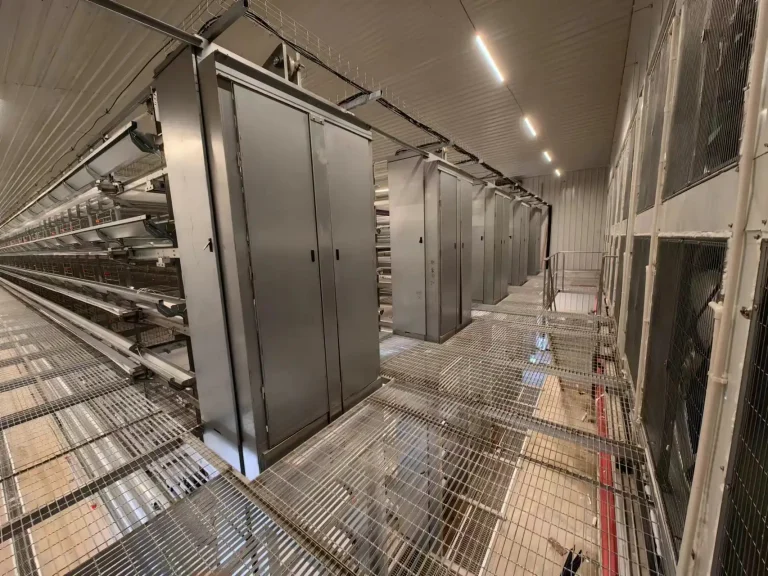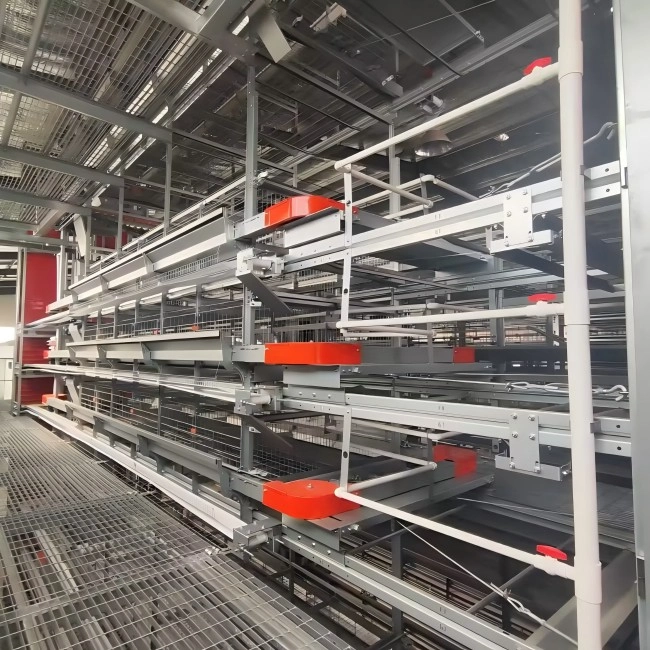Understanding Poultry Drinking Systems
Definition of Poultry Drinking Systems
Water systems for poultry play a role in contemporary poultry agriculture by offering birds uninterrupted access to fresh and clean water sources to support their health and productivity effectively. They are tailored to meet the requirements of various poultry varieties such as chickens, ducks and turkeys. The core aim of these systems is to provide water while reducing wastage and upholding cleanliness standards.
Types of Poultry Drinking Systems
Various options for poultry drinking systems exist with benefits and compatibility based on the size and nature of the poultry business you run. The usual kinds consist of below:
- Nipple drinkers are highly popular for their effectiveness in providing water to the birds with minimal waste.These systems are versatile and can be adjusted to different heights based on the size of the birds making them suitable for various types of poultry species.
- Bird keepers frequently utilize bell drinkers in establishments or open-range environments; these drinking devices feature a bell-shaped container that dispenses water when birds peck at it.The upkeep involves regular cleaning but is generally straightforward to manage.
- In setups or farms where many birds are kept together at once and need access to water simultaneously trough drinkers are commonly utilized.They involve channels that hold water and can cater to multiple birds simultaneously. However, they need regular cleaning to avoid contamination.
- Birds that use cup drinkers are served water in cups that are activated by their beaks which helps in conservating water efficiently though they may need more upkeep than nipple drinkers.
Mechanism and Principles of Poultry Drinking Systems
Core Components of a Chicken Drinking System
In a chicken watering system, there are essential parts that are meant to function in harmony.
- Origin of Water Supply Point:This location serves as the starting point for water intake into the system. It may consist of a tank or reservoir or a direct link to the plumbing infrastructure.
- Maintaining a regulator in the system helps to keep the water pressure to prevent leaks and ensure an even flow from all outlets.
- Channels and Tubes are used to move water from its origin to locations inside the poultry structure where it needs to be delivered.
- Places for Birds to Drink From:These can be nipples or cups or other ways birds get to their water source.
- The filtration system works to eliminate any impurities in the water supply before delivering clean water to the birds.
- Flow control valves enable you to adjust water flow rates based on requirements or the ages of the birds you are caring for.
Working Principles of Automatic Drinking Systems for Poultry
Automatic watering systems for poultry are built on methods aimed at improving efficiency and reducing the need for intervention.
- Automatic pressure control systems help keep pressure levels stable by using regulators to ensure that water is evenly distributed to all drinking points without causing any leaks.
- Water can be provided to the facility by either utilizing a gravity feed from a tank or utilizing a pump system to maintain a consistent flow irrespective of the height variations within the building.
- Activation Mechanisms:Birds trigger these systems by interacting with nipples or cups that dispense water in quantities only when required to conserve resources and promote cleanliness by minimizing stagnant water accumulation.
- Automated Cleaning Cycles are included in sophisticated systems to regularly flush pipes and outlets for preventing the accumulation of algae or bacteria and maintaining healthier environments for poultry.
Knowing about these systems can assist you in choosing and setting up an automatic water supply system designed to meet the specific requirements of your poultry farm operations effectively. Setting it up correctly not boosts the well being of the birds but also boosts the overall productivity of the farm by cutting down on labor expenses linked to traditional watering methods.
Steps to Install a Poultry Drinking System
Pre-installation Preparations
Before setting up a drinking system for poultry birds in your facility, it’s important to make necessary preparations beforehand. Firstly evaluate the layout of your poultry farm to decide on the setup for the drinking system. This includes finding the spots for water pipelines and distribution networks according to the number of birds and how they are housed. Make sure you have all the required equipment like pipes regulators valves and water outlets for installation. Making sure your water supply is dependable and can consistently deliver an amount of water at the right pressure levels.
Installation Process for an Automatic Drinking System for Poultry
Setting Up the Water Supply Line
The initial task during the setup phase involves connecting the water supply line to your water source be it a tank or a direct plumbing connection with suitable fittings linked to the main pipeline to guarantee only purified water flows into the distribution network; then place a regulator along the supply line to uphold a steady pressure across the system. This arrangement will serve as the core of your water distribution system for chickens in your poultry house to ensure delivery of water to every corner of the area.
Installing the Distribution Network
Now move forward with setting up the distribution network in your poultry facility by laying down pipes or tubing from the water supply to each designated drinking spot. Use elbows as necessary to navigate around corners and obstacles within the building. Make sure all connections are firmly secured and free of leaks by testing them under pressure before moving to the next step. Place drinking outlets—like nipples or cups—at intervals, along these lines depending on the number and type of birds you have. Make sure to set the heights based on the size of the birds to make it easier for them to access while reducing any chances of spills occurring.
Configuring Automatic Controls and Sensors
Setting up a drinking system for poultry is completed by adjusting the automatic controls and sensors at the end of the process. These parts play a role in enhancing the efficiency of the system by managing flow rates and initiating cleaning routines automatically. Place flow control valves across the network to enable modifications based on distinct requirements or the age categories of birds. Integrate sensors that oversee water level changes in pressure and detect leaks within the system to send alerts or shut down operations when anomalies are identified. Set up automated cleaning schedules using timers or programmable logic controllers (PLCs) if they are accessible to guarantee the flushing of pipes without the need for manual involvement.
Post-installation Checks and Maintenance
After you finish installing the system make sure to check that everything is working correctly by testing all parts of your poultry drinking setup. Check for any leaks at each connection while the system is running and fix them away before moving on. Test out the activation methods like nipples or cups with birds around and watch how they use these outlets carefully for a few days.
It’s important to keep up with maintenance to ensure your system runs smoothly in the run. Make sure to check things regularly like cleaning filters and replacing any old parts as needed and stay on top of sensor readings to adjust settings for changing conditions, such as temperature shifts that can impact evaporation rates and so on.
Introduction to Zeus: A Reliable Provider
Why Choose Zeus for Your Automatic Poultry Drinking Water System?
Zeus is known for being a trusted supplier in the field of automated poultry drinking water system thanks to its dedication to delivering top-notch products supported by decades of industry expertise. Their poultry products are designed to cater to a range of needs across different types and sizes of operations worldwide.
Opting for Zeus entails utilizing technology aimed at improving productivity while reducing waste and addressing hygiene issues. Additionally, they provide features that enable customers to tailor the systems to meet their specific requirements ensuring smooth integration with existing setups effortlessly.
Customer Support and After-Sales Service from Zeus
One convincing factor to choose Zeus is the outstanding customer service and support offered consistently throughout the entire product ownership journey. From consultation to installation help and ongoing maintenance, troubleshooting guidance is accessible from a dedicated team of experts who are always ready to assist whenever and wherever needed ensuring smooth operation with minimal downtime at all times.
Moreover, our warranty includes coverage as part of the standard package. This provides peace of mind knowing that your investment is protected in case any unexpected events occur in the future. This further enhances our reputation for delivering excellence and ensuring customer satisfaction at every stage of the process. Our goal is to build long-term partnerships with clients based on trust and reliability.
FAQ
Q: What are the different types of poultry drinkers?
A: In the poultry industry, they commonly use three types of drinkers; bell/trough drinkers nipple drinkers without cups and nipple drinkers with cups. Each type of drink has its advantages and disadvantages.
Q: How do poultry drinkers work?
A: The idea involves having a container of water with an opening at the base that lets water from the container flow into a tray or dish below it. When the water level in the tray is higher than the hole in the container the reservoir can’t take in air. No additional water can escape.





